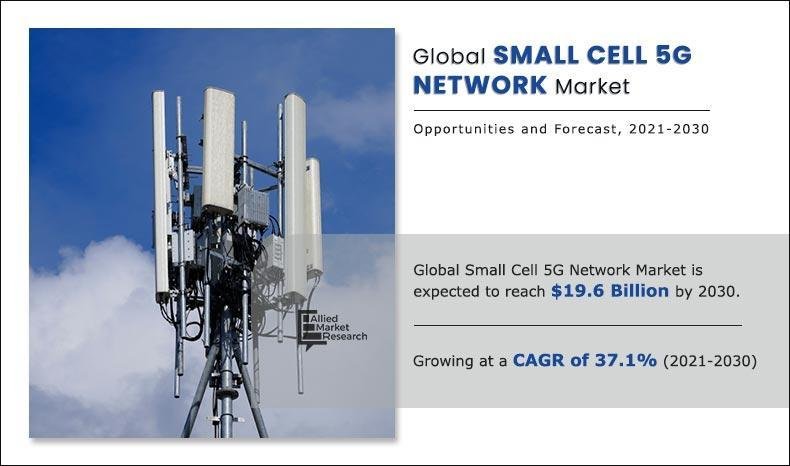A Small Cell 5G Network refers to a compact, low-powered cellular base station that helps enhance 5G coverage and capacity in specific, often densely populated, areas. Unlike traditional large cell towers, small cells are designed to cover short distances and are typically deployed in urban environments, stadiums, malls, offices, and even homes to strengthen signal quality and support high data rates.
Download Sample Report (Get Full Insights in PDF – 625 Pages) at: https://www.alliedmarketresearch.com/request-sample/5973
These cells play a critical role in 5G infrastructure by enabling faster speeds, lower latency, and greater connectivity for a growing number of smart devices. They are essential for supporting advanced technologies like IoT, autonomous systems, and ultra-reliable communications by densifying the network and offloading traffic from larger macro cells.
According to a recent report by Allied Market Research titled, the global small cell 5G network market was valued at $858 million in 2020 and is projected to reach $19.63 billion by 2030, registering a compound annual growth rate (CAGR) of 37.1% over the forecast period.
The rapid growth of this market is largely attributed to several key drivers. Among these are the rising levels of network densification, the surge in mobile data consumption, and the emergence of the Citizens Broadband Radio Service (CBRS) band, which collectively enhance the deployment of small cell 5G networks.
Buy Now & Get Exclusive Report at: https://www.alliedmarketresearch.com/small-cell-5g-network-market/purchase-options
In addition, increased investments by governments and telecom operators worldwide in 5G infrastructure further fuel market expansion. However, the sector faces certain challenges, including complexities in small cell deployment and concerns surrounding backhaul connectivity, which may act as restraints to growth. On the brighter side, opportunities such as the increasing adoption of the Internet of Things (IoT) and the growing demand for ultra-reliable, low-latency communications are expected to create promising prospects for the market in the years ahead.
In terms of components, the solutions segment held the largest market share in 2020. This dominance is attributed to the widespread use of small cell 5G solutions in integrating various technological elements within network devices. Their ability to support hyper-dense network environments and transition to scalable architectures is driving demand across different verticals. Despite this, the services segment is expected to experience the highest growth rate during the forecast period, as more industries are opting for comprehensive service packages to support their digital transformation initiatives.
About radio technology, standalone small cells-which are primarily used for enhancing indoor wireless coverage-were the leading segment in 2020. However, the non-standalone segment is anticipated to grow at a faster pace throughout the forecast period. The shift toward non-standalone deployments is being driven by rapid digital transformation across multiple industry verticals, coupled with increasing governmental efforts to build more connected, digital infrastructure.
Access the full Report Summary at: https://www.alliedmarketresearch.com/small-cell-5g-network-market
The impact of the COVID-19 pandemic on the small cell 5G network market has been relatively minimal. In fact, the crisis has accelerated the development of 5G infrastructure in several emerging economies, where public and private entities have collaborated to strengthen digital connectivity. For instance, in Thailand, mobile network operators are working together to deploy 5G infrastructure in hospitals, while the government’s Eastern Economic Corridor (EEC) initiative has mandated that 5G coverage must reach at least 50% of designated industrial zones by the end of 2020. Although the projected market size for 2030 is slightly lower than pre-pandemic estimates, the overall outlook remains robust.
Governments across developing nations are also actively investing in industrial automation, which is expected to generate substantial opportunities for small cell 5G network deployment. These investments are often accompanied by broader infrastructure improvements, such as the establishment of advanced data storage facilities to support the growing demands of 5G networks.
Key findings from the report include:
By component, the solutions segment held the largest market share in 2020, but the services segment is projected to see the fastest growth in the coming years.
In terms of radio technology, standalone systems generated the highest revenue in 2020 and are expected to maintain strong growth.
The millimeter wave (high-band) frequency segment accounted for the largest revenue share in 2020 and is expected to grow at the fastest rate through 2030.
Among cell types, picocells led the market in revenue in 2020, although microcells are anticipated to register the highest growth rate moving forward.
Regionally, North America dominated the global market in 2020; however, the Asia-Pacific region is poised for significant growth in the years ahead.
If you have any special requirements, Request customization: https://www.alliedmarketresearch.com/request-for-customization/5973
Key players profiled in the study include major industry contributors such as Altiostar Networks, Inc., Aviat Networks, Inc., Baicells Technologies, Blinq Networks, Cambium Networks Corporation, Casa Systems, Inc., Ceragon Networks Ltd., Comba Telecom Systems Holdings Ltd., Contela Inc., Shenzhen Gongjin Electronics Co., Ltd., IP. Access Ltd., Pctel, Qucell Inc., Radisys Corporation, and Radwin. The report offers a comprehensive analysis of current market trends, growth drivers, and future investment opportunities to guide stakeholders in strategic decision-making.
Asia-Pacific is expected to observe highest growth rate during the forecast period. The mobile cellular industry in Asia-Pacific is rolling out diverse technical and commercial solutions with the arrival of small cells for 5G networks. This is a major factor driving the adoption of small cell 5G networks in this region. State-owned mobile operators in China such as China Mobile, China Unicom, and China Telecom has invested in a 5G national action plan to orchestrate its industry R&D and deployment efforts through central government support. According to study published by the European Parliament, the overall investments are expected to be high and for long term, to 2030, with at least $30.76 billion per year.
For Purchase Enquiry: https://www.alliedmarketresearch.com/purchase-enquiry/5973
Contact:
David Correa
1209 Orange Street,
Corporation Trust Center,
Wilmington, New Castle,
Delaware 19801 USA.
Int’l: +1-503-894-6022
Toll Free: + 1-800-792-5285
UK: +44-845-528-1300
India (Pune): +91-20-66346060
Fax: +1-800-792-5285
help@alliedmarketresearch.com
About Us:
Allied Market Research (AMR) is a full-service market research and business-consulting wing of Allied Analytics LLP based in Portland, Oregon. Allied Market Research provides global enterprises as well as medium and small businesses with unmatched quality of “Market Research Reports” and “Business Intelligence Solutions.” AMR has a targeted view to provide business insights and consulting to assist its clients in making strategic business decisions and achieving sustainable growth in their respective market domains.
Pawan Kumar, the CEO of Allied Market Research, is leading the organization toward providing high-quality data and insights. We are in professional corporate relations with various companies. This helps us dig out market data that helps us generate accurate research data tables and confirm the utmost data procurement methodology includes deep presented in the reports published by us is extracted through primary interviews with top officials from leading online and offline research and discussion with knowledgeable professionals and analysts in the industry.
This release was published on openPR.



















